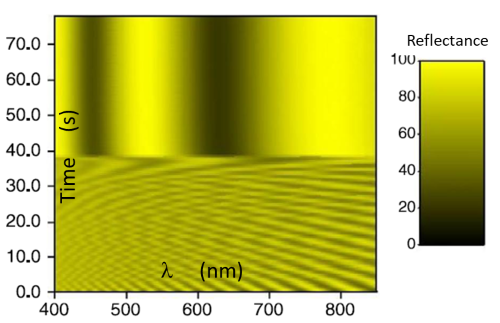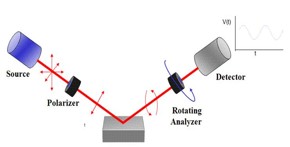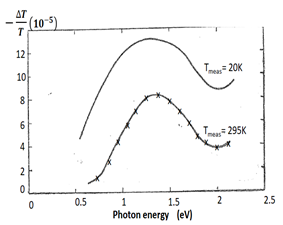
A Scout representation of water evaporation from a complex fluid (see https://doi.org/10.1007/s11998-019-00218-1)
These are some stations along my journey in physics. Thank you for your visit.
For the entire publication, klick on the title for the link.
1 . Spectra-ellipsometry for latex film formation
 |
The philosophy of the ellipsometry method consists on measuring the so-called spectroscopic parameters: Y and D using the reflection measurement with the experimental arrangement shown in Figure 1. Then, defining a good model the measured spectra of these parameters are simulated based on the optical constants and thickness of the layers that form the sample.
|
2. VIS-optical spectroscopy revealing the dynamics of physical processes
 |
In the field of thin films characterization, the VIS optical spectroscopy is an important tool. The method here presented has been extensively described by us elsewhere (J. Coat. Technol. Res. (2019), https://doi.org/10.1007/s11998-019-00218-1)
The aim of this work is to briefly introduce to the reader an extraordinary powerful tool. Because, as a Hawaian proverb says: “no rain, no rainbow!”.
|
3. Automatic Scanning Absorptometer
 |
- The Automatic Scanning Absorptometer (ASA) is a modern version of the Bristow method and is used to characterize the liquid absorption into thin porous media. The method of measurement is described in this work. Once the measurement started, the ASA software will take over and life the transferred liquid volume normalized to the contact area (TLV/A) will be displayed as a function of square root of the contact time.
The liquid properties (surface tension, viscosity, contact angle, etc) and the characteristics of the porous material (porosity, surface energy, fibrous or granular internal structure) defines the liquid absorption dynamics. - (this work was made in Océ Technologies, R&D, published in Che. Eng. Sci. https://doi.org/10.1016/j.ces.2017.12.024)
|
-
4. Silicon Oxide (SiOx, 0<x<2): a Challenging Material for Optoelectronics
|

- total downloads:
- 8360
|
The IR spectroscopy revealed the increasing of the Si-O bonds' number and the Raman investigations showed the increase of the Si-Si number when the SiOx sample has been laser irradiated. Increasing the energy delivered into the material, more oxygen-rich and silicon-rich material has been detected. Increasing more the energy delivered to the SiOx it is possible to induce the phase separation (silicon and SiO2 ) together with the phase transformation: from amorphous into crystalline silicon.
(this work was made in Océ Technologies, R&D, published in Optoelectronics - Materials and Techniques:DOI: 10.5772/20156)
|
5. OES studies during the a-SiOx deposition by reactive r.f. magnetron sputtering
|

|
- Optical Emission Spectroscopy (OES) was employed to study the plasma used in silicon suboxides SiOx depositions. Theoretical calculations performed in the frame of electron impact excitation mechanism for argon and atomic oxygen corroborated with electron impact dissociation of the molecular oxygen have shown the strong influence of the electron temperature on the rate coefficients of photons' production.
Correlation functions between the OES signals assigned to silicon and oxygen atoms from plasma (gas phase) and the SiOx layer composition (infrared and energy dispersive X-ray investigated) have been found. Based on these functions, the OES plasma monitoring is proposed as a tool to control in-situ and in direct time the SiOx layer composition. - (this work was made in Utrecht University, prof. FHPM Habraken 2002 and continued at Océ Technologies B.V. 2005)
|
6. Plasma magnetic multipole confinement used in PECVD a-C:H depositions
 |
During plasma deposition of a-C:H thin films, carbon atoms can form sp3, sp2 and sp1 sites; the chemical and physical properties of the a-C:H films are determined by the fractions of these sites.
In this work we report on an investigation of a magnetic- multipole system to confine the plasma targeting the increase of sp3 sites specific to “diamond like” carbon (DLC). The mechanical and tribological properties, the photoluminescence as well as the electron field emission from a-C:H layers are dependent on the sp3/sp2 ratio. Interesting results concerning the magnetic field effect on both plasma parameters and film properties are here revealed.
(this work was made in Cambridge University, Engineering Depart. prof. Bill Milne 1997)
|
7. Optical Modulation Spectroscopy (OMS) used to study thin films of a-SiC:H
|

|
OMS techniques were used to study the a-SiC:H alloys with different carbon content. The energy distribution of the localized states into the band-tails as well as those as dangling bonds (DB) as deep states. The room temperature measurements allow us to determine the position of the DB states in the energy gap. The experimental results are fitted with Gaussian distributions for D0 and D-. An increase in the transition energies involving D0 and D- states and the conduction band has been determined for alloys with two different r values.
- From the experimental data fit, the Fermi level and the quasi-Fermi levels positions are dedtermined. A good agreement with optical measurement of the energy gap was found.
- (this work was made in KU Leuven, prof. G. Adriaenssens and prof. W. Grevendonk, 1994)
|
8. Photoconduction in a-Si:H - a point of view
|

|
- The photoconductivity of hydrogenated amorphous silicon (a-Si:H) thin films is still of interest. A variety of models have been proposed to investigate the steady-state photoconductivity in the samples obtained under various physical conditions. The photo-generation of carriers combined with the electron trapping and recombination kinetics have been treated in the frame of the classical photoconductivity theory; different models have been elaborated considering the kinetic equations for electron and hole capture as well as the thermal emission. However, in the quoted works a peculiar attention has been devoted to the behavior of the lux-ampere characteristics, these curves being generally approximated by some straight lines with various slopes in a definite temperature range.
- his work was developed during my PhD studies in Bucharest University prof I. Munteanu, prof I. Licea, 1994)
|





